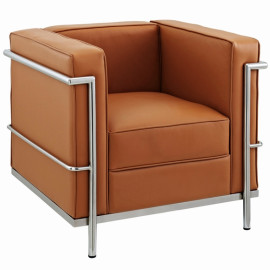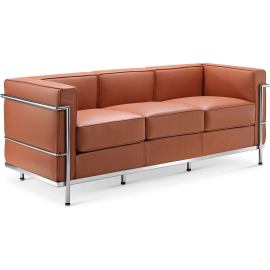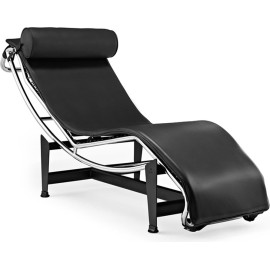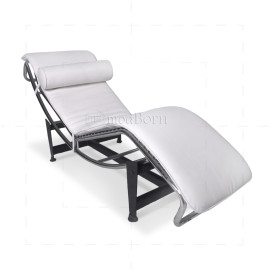Your shopping cart is empty!
LC2 Armchair – 1 Seater Black Leather
Discover Timeless EleganceExperience the iconic design of Le Corbusier Style with the LC2 Armchair. This 1 seater black leather armchair, inspired by international modernism, offers a perfect fusion of art, comfort, and luxury for your home or office.Unmatched Comfort and Designer CraftsmanshipDesigned to cradle the body, its ergonomic form and pre..
LC2 Armchair 1 Seater Cognac Leather
The LC2 is designed in the distinct International style for a historical fine art exposition, the 1929 Salon d'Automne. Sofa is the ultimate relaxing machine. It was originally designed as a modernist response to the traditional club chair by providing the ultimate comfort and good design. It is the perfect way to relax i..
LC2 Armchair 1 Seater white Leather
The LC2 is designed in the distinct International style for a historical fine art exposition, the 1929 Salon d'Automne. Sofa is the ultimate relaxing machine. It was originally designed as a modernist response to the traditional club chair by providing the ultimate comfort and good design. It is the perfect way to relax i..
LC2 Sofa 2 Seater Black Leather
The LC2 is designed in the distinct International style for a historical fine art exposition, the 1929 Salon d'Automne. Sofa is the ultimate relaxing machine. It was originally designed as a modernist response to the traditional club chair by providing the ultimate comfort and good design. It is the perfect way to rel..
LC2 Sofa 2 Seater Cognac Leather
The LC2 is designed in the distinct International style for a historical fine art exposition, the 1929 Salon d'Automne. Sofa is the ultimate relaxing machine. It was originally designed as a modernist response to the traditional club chair by providing the ultimate comfort and good design. It is the perfect way to relax i..
LC2 Sofa 2 Seater white Leather
The LC2 is designed in the distinct International style for a historical fine art exposition, the 1929 Salon d'Automne. Sofa is the ultimate relaxing machine. It was originally designed as a modernist response to the traditional club chair by providing the ultimate comfort and good design. It is the perfect way to relax i..
LC2 Sofa – 3 Seater Black Leather
Timeless Modernism in Designer SeatingInspired by the international style showcased at the 1929 Salon d'Automne, the LC2 Sofa embodies the refined vision of Le Corbusier Style. This 3 seater black leather sofa is styled to provide the ultimate in relaxation and aesthetic sophistication for both home and office environments.Unrivalled Comfort and Fu..
LC2 Sofa 3 Seater Cognac Leather
The LC2 is designed in the distinct International style for a historical fine art exposition, the 1929 Salon d'Automne. Sofa is the ultimate relaxing machine. It was originally designed as a modernist response to the traditional club chair by providing the ultimate comfort and good design. It is the perfect way to relax i..
LC2 Sofa 3 Seater White Leather
The LC2 is designed in the distinct International style for a historical fine art exposition, the 1929 Salon d'Automne. Sofa is the ultimate relaxing machine. It was originally designed as a modernist response to the traditional club chair by providing the ultimate comfort and good design. It is the perfect way to relax i..
LC4 Chaise Longue Black Leather
LC4 chaise longue is the ultimate relaxing machine. Chaise is designed with a very specific purpose – to serve our limbs by providing the ultimate in comfort and good design. The curvature of the le corbusier chair is ergonomically designed to mold to your body for maximum comfort and relief. Chaise longue is the perfect way to relax in your home o..
LC4 Chaise Longue White Leather
LC4 chaise longue is the ultimate relaxing machine. Chaise is designed with a very specific purpose – to serve our limbs by providing the ultimate in comfort and good design. The curvature of the le corbusier chair is ergonomically designed to mold to your body for maximum comfort and relief. Chaise longue is the perfect way to relax in your home o..
LC4 Chaise Longue – Brown Leather
Ultimate Relaxation & Designer EleganceExperience the pinnacle of comfort with the LC4 chaise longue, styled in the iconic Le Corbusier manner. Expertly designed to mold to your body, this chaise longue in brown leather offers a sublime blend of form, function, and art—perfect for both home and office settings.Artistry Meets FunctionalityInspir..
LC4 Chaise Longue Pony Leather
LC4 chaise longue is the ultimate relaxing machine. Chaise is designed with a very specific purpose – to serve our limbs by providing the ultimate in comfort and good design. The curvature of the le corbusier chair is ergonomically designed to mold to your body for maximum comfort and relief. Chaise longue is the perfect way to relax in your home o..









































